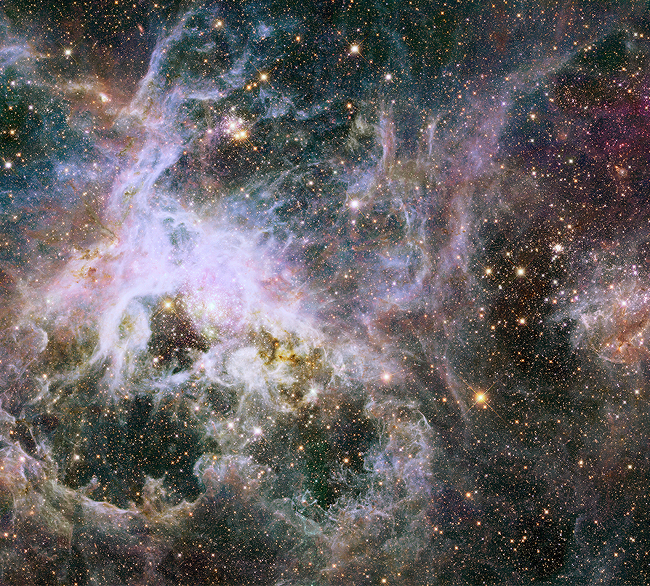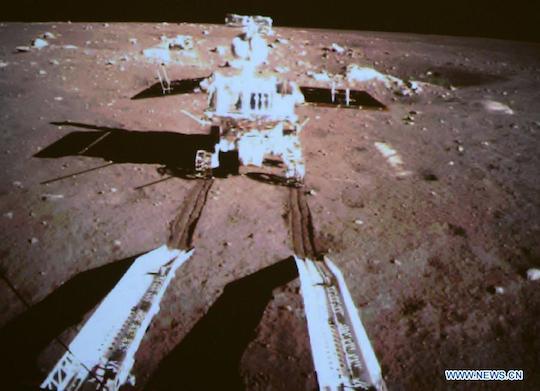This article is more than 1 year old
Ground control to 2014: A year in Space
Four-legged landings and history-making comet-chasers
Off-world extreme driving challenge
NASA veteran 'bot Opportunity claimed humanity's off-world long distance driving record after driving more than a kilometre farther than the Lunokhod 2 the Soviet Union sent to the Moon in 1973 managed. It also spotted the mysterious Martian doughnut that caused so much consternation, someone sued NASA over it. Sadly, it turned out to be just a regular old rock that probably got kicked into view by the rover's wheel or even from a nearby meteorite strike.

AWESOME SPACE PIC 3: A Hubble mosaic, spanning a width of 600 light-years, of a star factory of more the 800,000 stars being born inside the Tarantula Nebula. Credit: NASA, ESA, and E. Sabbi/STScI
Curiosity also had a busy year, clocking up its 500th sol on the Martian surface and celebrating its first full Martian year on Mars.
In between the milestones, Curiosity found time to scale a metre-high sand dune, trundle through the red sands of Mars backwards, drill into the sandstone slab dubbed Windjana, spot a a massive iron meteorite half buried beneath the surface, discover that the three-mile-high Mount Sharp was once under a large lake and successfully complete the first stage of its ongoing mission.
In other NASA news, the space agency took the first step towards rekindling its manned exploration mission with the Apollo-like successor spacecraft Orion. The agency, and manufacturer Lockheed Martin, are hoping that Orion will eventually take astronauts to Mars, after the craft blasted off on its first test flight this year.
Although it didn't get off quite as scheduled, what with boats, high winds and stubbornly non-closing fuel valves, Orion did make it into space for its high elliptical orbit through the lower Van Allen radiation belt and safely back down again to splash into the Pacific Ocean.
The spacecraft took off this time on a Delta IV Heavy rocket, but NASA is aiming to strap its in-development Space Launch System to Orion in the long term. That is, if it can scrabble together the cash to finish building it.

China's Jade Rabbit on the Moon
NASA and ESA weren't the only space agencies to see success this year either. China's Jade Rabbit was trundling around on the Moon and despite a "mechanical abnormality" that it bravely fought, but eventually succumbed to, marked a significant success for the country.
India also had a historic year when it became the first nation to achieve a successful insertion to Mars orbit on its first attempt, after an epic 10-month trek by its cunning Mangalyaan (aka Mars Orbiter Mission, or MOM) spacecraft. The cheap and cheerful craft came in at a fraction of the cost of NASA's newest Martian probe MAVEN, which made it into orbit shortly after MOM.
The growing world of private space exploration had its ups and its downs in 2014. Most tragically, one test pilot lost his life and another was injured when Virgin Galactic's SpaceShipTwo crashed in the Mojave Desert during a test flight.
Richard Branson immediately rushed to the scene and gave his condolences to the family and friends of the pilot. He echoed NASA's earlier comments, when he said; "Space is hard – but worth it. We will persevere and move forward together".
Although investigators from the National Transportation Safety Board are still investigating the accident, they did find that the co-pilot had manually unlocked the feathering system used for re-entry ahead of time, but didn't then select feather mode on the feathering handle. However the tail booms nonetheless folded upwards and the craft cracked up.
No other private space firm had as tragic an accident this year, but companies did have their issues. Just before Virgin Galactic's accident, an Orbital Sciences resupply mission to the International Space Station (ISS) blew up just after leaving the launchpad.
The destruction of the Antares rocket, which cost the firm over $200m on top of the loss of supplies and damage to the launchpad, was quickly blamed on the AJ26 first-stage rocket engine. The engine is made by Aerojet by rebuilding old NK-33 rocket engines designed by the then-Soviet Kuznetsov Design Bureau.
Orbital Sciences later said that it was planning to ditch the engines, after preliminary analysis of the telemetry from the failed launch suggested that a turbopump probably failed in one of the two first-stage main engines.
SpaceX also had an accident this year, when its Falcon 9 reusable prototype rocket burst into flames over the company's test flight area in Texas. Founder and tech entrepreneur Elon Musk tweeted:
Three engine F9R Dev1 vehicle auto-terminated during test flight. No injuries or near injuries. Rockets are tricky …
— Elon Musk (@elonmusk) August 23, 2014 